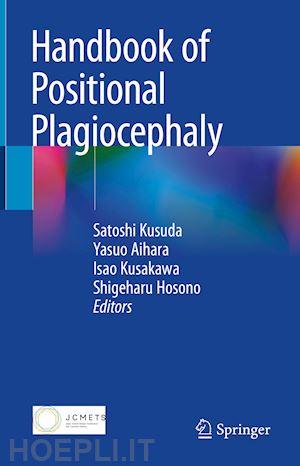
Questo prodotto usufruisce delle SPEDIZIONI GRATIS
selezionando l'opzione Corriere Veloce in fase di ordine.
Pagabile anche con Carta della cultura giovani e del merito, 18App Bonus Cultura e Carta del Docente
This comprehensive book provides details on infants' deformed scalps and the early detection of severe positional plagiocephaly. Many health professionals involved in infant health care believe that positional head shape changes are only temporary and will return to normal shape on their own. However, some of them may develop a deformed scalp shape later in life, which can result in malocclusion. Early and appropriate intervention may improve outcomes in patients with positional plagiocephaly; however, all healthcare professionals caring for infants must pay much more attention. The purpose of this book is to standardize the diagnosis and treatment of infants with positional plagiocephaly. This book addresses the prevention of head deformity in infancy as well as the most recently developed helmet therapy.
Handbook of Positional Plagiocephaly is an official publication of the Japan Cranial Medical Examination and Treatment Society (JCMETS), published to raise awareness and foster understanding among health professionals involved in infant health care, such as pediatricians, pediatric neurosurgeons, pediatric surgeons, plastic surgeons, obstetricians, nurses, midwives, and parents. Professionals such as pediatricians and pediatric neurosurgeons contributed as chapter authors, resulting in content that is both comprehensive and easy to understand for readers of all levels.
Part I Overview.- Chapter 1 Overview.- Part II Assessment and evaluation of positional plagiocephaly at grouped infant checkups or private pediatric clinics.- Chapter 2 Causes and progress of positional plagiocephaly and its diagnosis.- Chapter 3 Prevention and timing of referral to specialists.- Part III Diagnosis and treatment at specialized hospitals.- Chapter 4 Basic knowledge of plagiocephaly.- Chapter 5 Mechanism of positional plagiocephaly.- Chapter 6 Differential and definitive diagnosis.- Chapter 7 Effect on other organ systems.- Chapter 8 Early diagnosis at infant checkup.- Chapter 9 Medical interview and physical examination.- Chapter 10 Objective diagnostic tools.- Chapter 11 Effectiveness of helmet therapy.- Chapter 12 Feedback from specialized hospitals.- Chapter 13 Mechanisms of helmet therapy.- Chapter 14 Actual use of helmet.- Chapter 15 Helmet therapy for specific diseases.- Chapter 16 Issues and future directions of helmet therapy.- Part IV Questions and Answers.- Chapter 17 Questions and Answers.











Il sito utilizza cookie ed altri strumenti di tracciamento che raccolgono informazioni dal dispositivo dell’utente. Oltre ai cookie tecnici ed analitici aggregati, strettamente necessari per il funzionamento di questo sito web, previo consenso dell’utente possono essere installati cookie di profilazione e marketing e cookie dei social media. Cliccando su “Accetto tutti i cookie” saranno attivate tutte le categorie di cookie. Per accettare solo deterninate categorie di cookie, cliccare invece su “Impostazioni cookie”. Chiudendo il banner o continuando a navigare saranno installati solo cookie tecnici. Per maggiori dettagli, consultare la Cookie Policy.